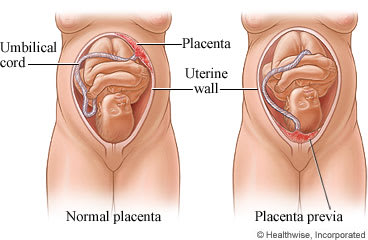Overview

The placenta forms during pregnancy. It gives the baby nutrients and oxygen. It also removes waste products. Normally, the placenta attaches to the inner wall of the uterus, away from the opening of the uterus. Sometimes the placenta attaches so low that it blocks all or part of the opening. This is called placenta previa.
Sometimes placenta previa goes away on its own over time. If you continue to have placenta previa, most of the time a cesarean delivery will be done. Your doctor or midwife will watch you closely until your baby can be safely delivered.
Follow-up care is a key part of your treatment and safety. Be sure to make and go to all appointments, and contact your doctor if you are having problems. It's also a good idea to know your test results and keep a list of the medicines you take.
How can you care for yourself at home?
- Ask your doctor or midwife about what activity you can do. They may recommend that you avoid heavy activity, such as running or heavy lifting.
- Have a phone nearby at all times. If you start to bleed, you will need to call your doctor or midwife right away.
- Tell all doctors, midwives, and nurses who examine you that you have placenta previa. This will affect the type of pelvic exam they may do.
- Ask your doctor or midwife if you can have sex. They may recommend that you not have vaginal sex and that you avoid any sexual activity that leads to orgasm.
- Do not put anything, such as tampons or douches, into your vagina. Use pads if you are bleeding, and call your doctor or midwife right away.
When should you call for help?
Call 911 anytime you think you may need emergency care. For example, call if:
- You passed out (lost consciousness).
- You have severe vaginal bleeding. You have soaked through one or more pads in an hour, and the bleeding is not slowing down.
- You have sudden, severe pain in your belly or pelvis.
Call your doctor now or seek immediate medical care if:
- You have any vaginal bleeding.
- You are dizzy or lightheaded, or you feel like you may faint.
- You have pain in your belly, pelvis, or lower back.
- You think that you are in labor.
- You have a sudden release or slow trickle of fluid from your vagina. This may mean your water has broken.
- You've been having regular contractions for an hour. This means that you've had at least 6 contractions within 1 hour, even after you change your position and drink fluids.
- You notice that your baby has stopped moving or is moving less than normal.
Watch closely for changes in your health, and be sure to contact your doctor if you have any questions or concerns.
Where can you learn more?
Go to http://www.healthwise.net/patientEd
Enter A070 in the search box to learn more about "Placenta Previa: Care Instructions".
Current as of: July 15, 2025
Author: Ignite Healthwise, LLC Staff
Clinical Review Board
All Ignite Healthwise, LLC education is reviewed by a team that includes physicians, nurses, advanced practitioners, registered dieticians, and other healthcare professionals.

